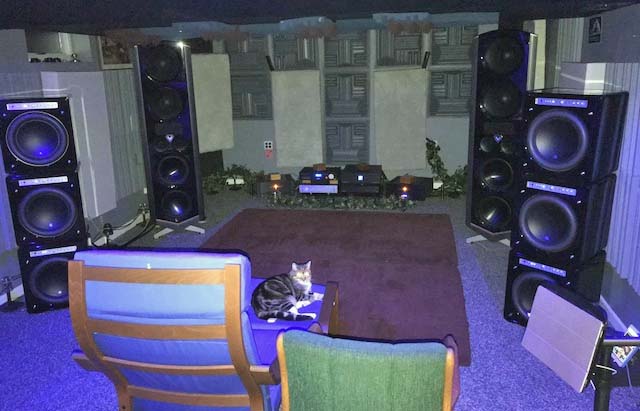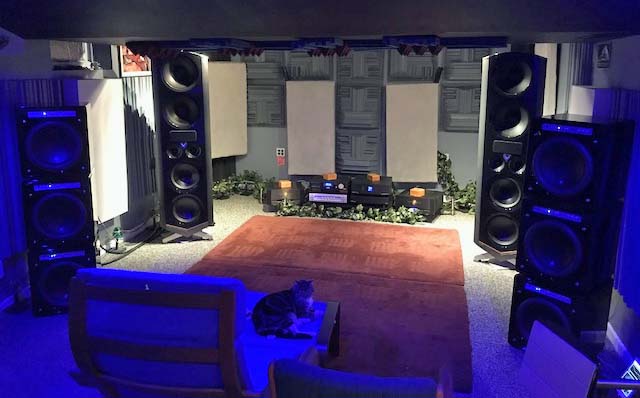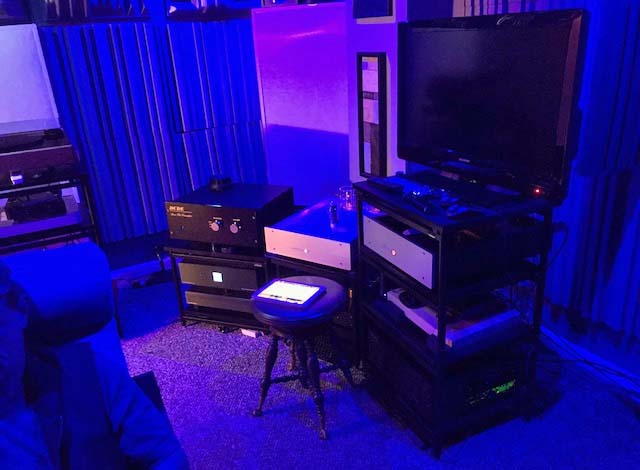Hi Martin,
Not sure what was incorrect. My point was that double runs of speaker wire will effectively reduce THE RESISTANCE OF THE WIRE by half. This can help the amplifier, as if the speaker wire itself was twice as thick. I did not mean to imply that it would affect the IMPEDANCE of the speaker (4 or 8 ohm) at all. Is this incorrect? The opposite corollary would be to change your wire to one of half the size. Wouldn’t this increase the resistance? Thanks, Ken
Be cautious bi-wiring with exotic speaker cables. Many high end speaker cables are designed with multiple braided wires or closely spaced flat wires to reduce induction. Induction can increase AC resistance at higher frequencies so reducing it should be a good thing. (Typically these frequencies are above the audible range and it can be argued there is no benefit). A side effect of these designs is an increase in capacitance. In typical speaker cable lengths this presents no problem…but, with bi-wiring the capacitance is additive and you could end up with significantly higher capacitance numbers, especially with longer lengths. Unlikely, but possibly enough to drive some amps into ultrasonic oscillations. For me, it’s jumpers for “exotics” and bi-wire for my favorites: BJC 10AWG or Canare Quad. The Quad does have slightly higher capacitance than the 10AWG (along with slightly lower induction) but not nearly as much so as many of the more exotic brands. As a side note, I don’t use a single quad star for biwiring (what some cable companies refer to as internal bi-wiring). The purpose of quad star wiring seems to be negated by running different frequencies through closely paired wires and in fact could cause signal induction from one to the other. The same could be said of any closely braided or twisted wire design…this is shear speculation on my part, and probably has no real world effect. Maybe some of our EE friends can set me straight?
No, it doesn’t reduce the resistance either (which is an oversimplification.) It will be Za + Zc + speaker impedance for each branch. But in reality the resistance of the cable is very small anyway.
Hi, the benefits of bi-wiring depend on the speaker used. In my experience, most makes would show some positive effects when signals travel independently through the wire. You may hear a more transparent sound image and more air. It is a matter of trying it out. The biggest obstacle for your amp and sound is the crossover in the speaker. Bi-amping will share that load between one or several amps, weaker amps will appreciate the additional help. But you will hear the greatest effect - and I am talking about a night & day difference - if you assign individual amps on each speaker driver, and manage their jobs via a digital crossover, preferably with digital sound processing. Life simply does not get any better!
Over many years I traveled up the route described above, and have since stopped looking for further improvements. Now it is time to simply enjoy the music.
IMHO Bi-wiring and passive bi-amping are pretty much a waste of time/effort/money and has yielded no audible benefits in tests I have done. Passive bi-amping actually made things worse due to tiny output differences between same model amps and thus changed the bass/treble balance subtly.
Active bi-amping OTOH is well known to often yield very significant improvement - this is where the crossover is before the amps and is for example the case with most decent powered studio monitor systems.
The headache with bi-amping (whether passive or active) is precisely matching the amps - best just leave that to active monitor designers.
As for bi-wiring, if you actually get an audible improvement - maybe a single thicker/lower resistance cable will yield the same improvement or maybe the improvement really came from re-attaching the cables.
B-Wiring is exactly as another user stated: “Buy Wire”. This includes tremendously overpriced exotic wires.
Resistance=Impedance (same thing)
Lets go through an example:
Resistance of pure copper 14ga wire is about 2.525 ohms per Thousand feet…or .0025 per foot.
http://hyperphysics.phy-astr.gsu.edu/hbase/Tables/wirega.html
Typical cable length for speakers is 15ft…so 15 x .0025 = .0379 ohm
adding another identical speaker wire halves the resistance to .01894 ohm
Ohms Law is I=V/R (Current=Voltage div by Resistance)
In this example–Assuming you have an even mediocre amplifier, and typical 8 ohm speakers. Current will remain the same, while voltage will increase by
1v/8.0379=.12441; then 1v/8.01894=.1247 . A difference of .00029 volt (since we are using both voltage and current values of ‘1’, we can convert to .00029%)
…or to db = -70.75204db
http://www.sengpielaudio.com/calculator-gainloss.htm
Thank kind of signal level is more than easily masked by the noise floor of your equipment, or even the birds outside.
There are those who claim to hear such things…and Good for them. They have probably never had to face a real 3rd party blind listening test.
Im a fan of Bob Carver, who once embarrassed those purveyors of magical trinkets (and exotic speaker wires) --with science.
As pointed out above, this is not correct. You are assuming that the cables are in parallel but they are not. Nonetheless, this doesn’t materially change your thesis.
My speakers are quad amped and biwired.
1 stereo amp go sub bass
1 stereo amp for bass
1 stereo amp for midrange
1 stereo amp for treble.
DSP for all 8 channels.
The Legacy Audio Vs.
I use active crossover speaker setups see www.linkwitzlab.com
I have lx521, Orion LXmini and Pluto
This is the ideal way to run with multiple amps imho
Wow … do you have photo’s to share?
Sure. Here you go. Besides being quad amped the Legacy Vs are controlled by the Wavelet preamp, DSP, DAC, and electronic digital crossover. I also have a six pack of JL Audio F-113 IIs. Front end in second picture consists of The Dude preamp, Lampizator Pacific, Auralic Aries G2, and Sota turntable.



Hmmm … I would reckon no shortage of SPL in that room, excellent, thanks for sharing.
Linn adopt a similar approach with their ‘Aktiv’ amplifier/speaker topography. One amplifier is used for each driver, hence the crossover in the speaker is effectively bypassed.
I took my Linn 4-way Majik 140’s this way, from passive, to fully ‘Aktiv’, using eight channels of amplification.
As you say, the difference is simply ‘night and day’.
The only ‘drawback’, is the EIGHT lengths of speaker cable needed to drive them 
Yep. Lots of cables. Luckily my sub bass and bass amplifiers are built into the Legacy Vs. But one still has to run interconnects to them which aren’t cheap and still take up room.
If Class D or T amps become as good as Class A amps I’d be in favor of built in amps for self powered speakers. The Legacy Audio Wavelet preamp, DAC, DSP, and crossover would be all one would need for a very awesome simple system. Although I still like my Dude preamp and Lampizator DAC better but they can feed the analog inputs of Wavelet so I have the best of both worlds.
I replaced the crappy plates that bridged the the biwire posts on mine with jumper cables made from the same speaker cable in my case Naim NACA5 it gave an uplift I was not expecting at all.
This -
Or this -
Then from everyone’s favorite web site -
Same here with my 804!